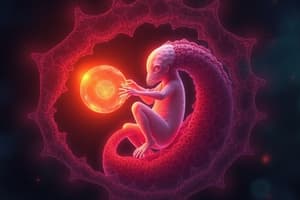Podcast
Questions and Answers
Which adaptation is most crucial for amniotes' successful transition to terrestrial life, distinguishing them from earlier tetrapods?
Which adaptation is most crucial for amniotes' successful transition to terrestrial life, distinguishing them from earlier tetrapods?
- The ability to synthesize vitamin D internally, reducing dependence on aquatic environments.
- The evolution of the amniotic egg with specialized membranes protecting the embryo. (correct)
- The development of a three-chambered heart for more efficient circulation.
- The presence of webbed feet allowing for locomotion on varied terrains.
An animal is discovered with an amniotic egg. Which other characteristic would be expected in this animal?
An animal is discovered with an amniotic egg. Which other characteristic would be expected in this animal?
- A permeable skin that facilitates cutaneous respiration.
- A larval stage that is dependent on an aquatic environment.
- Gills for oxygen exchange during its early development.
- Relatively impermeable skin to prevent water loss. (correct)
What evolutionary advantage does ventilating lungs via rib cage movements provide to amniotes, especially in comparison to earlier tetrapods?
What evolutionary advantage does ventilating lungs via rib cage movements provide to amniotes, especially in comparison to earlier tetrapods?
- It decreases the reliance on energy-intensive muscular contractions.
- It supports the development of vocalizations for communication.
- It facilitates underwater respiration for extended periods.
- It allows for more efficient and sustainable oxygen uptake in terrestrial environments. (correct)
Which of the following is NOT a membrane found in the amniotic egg?
Which of the following is NOT a membrane found in the amniotic egg?
How does the evolution of the amniotic egg contribute to the ecological diversity and distribution of amniotes compared to non-amniote tetrapods?
How does the evolution of the amniotic egg contribute to the ecological diversity and distribution of amniotes compared to non-amniote tetrapods?
Flashcards
Amniotes
Amniotes
A group of tetrapods including reptiles (including birds) and mammals, characterized by the amniotic egg.
Amniotic Egg
Amniotic Egg
The major derived characteristic that defines the amniote clade, containing membranes that protect the embryo.
Extraembryonic Membranes
Extraembryonic Membranes
The amnion, chorion, yolk sac, and allantois.
Amniote Terrestrial Adaptations
Amniote Terrestrial Adaptations
Signup and view all the flashcards
Study Notes
- Amniotes are a group of tetrapods comprising reptiles (including birds) and mammals.
- They are named after the amniotic egg, a key derived characteristic.
- The amniotic egg contains membranes that protect the embryo.
- These extraembryonic membranes include the amnion, chorion, yolk sac, and allantois.
- Amniotes possess terrestrial adaptations like relatively impermeable skin.
- They also have the ability to use the rib cage to ventilate their lungs.
Studying That Suits You
Use AI to generate personalized quizzes and flashcards to suit your learning preferences.




